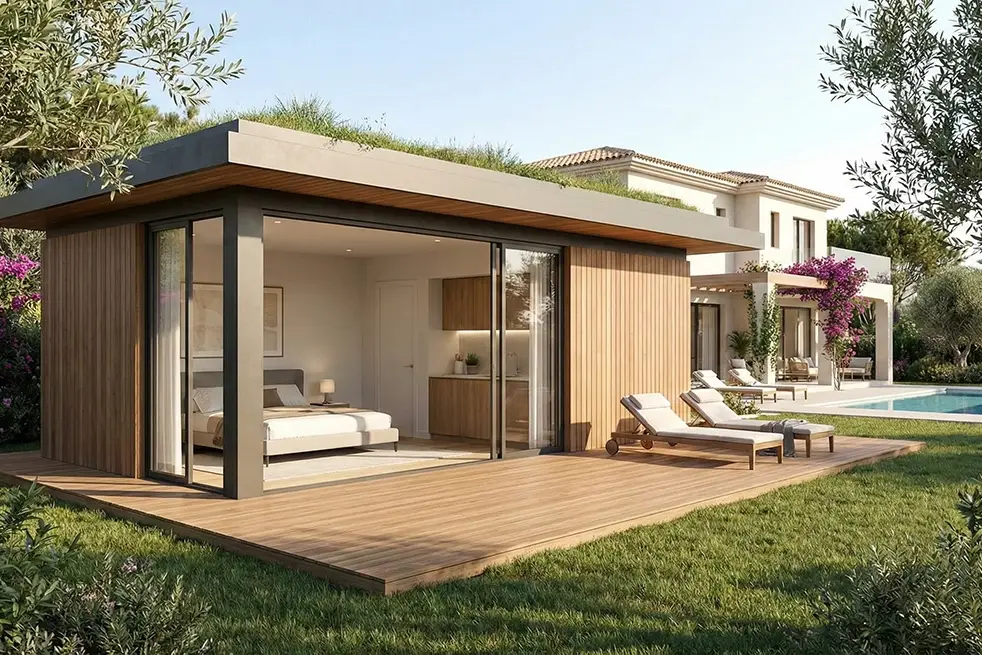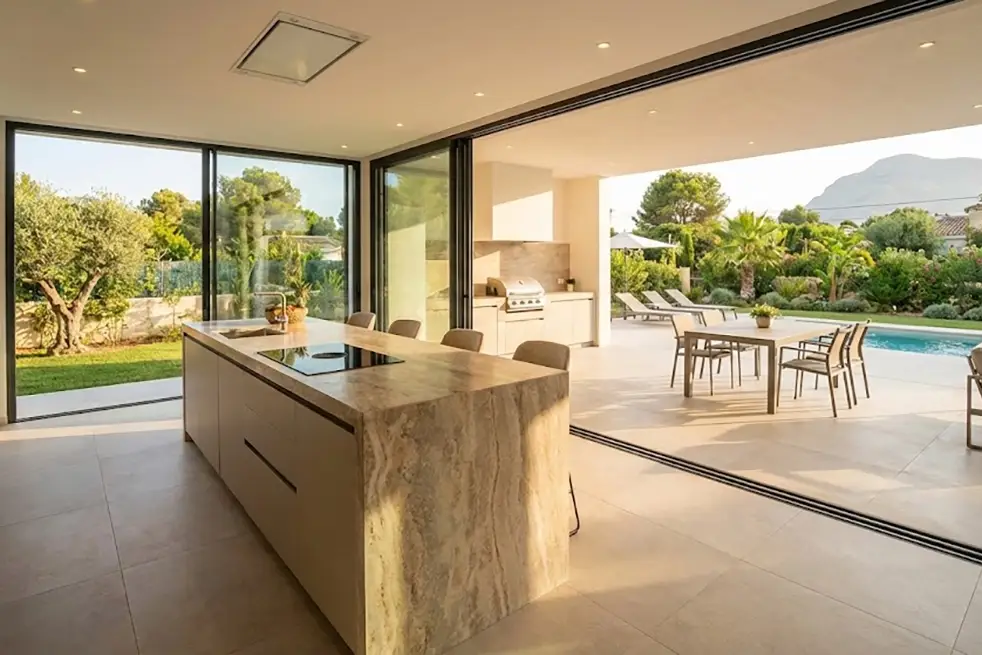Air renewal systems in homes are essential to ensure the indoor air quality and comfort of its inhabitants. In this article, we will explore the different types of ventilation systems, current regulations, the advantages and disadvantages of mechanical ventilation, heat recovery systems, and available assistance. We will also highlight the importance of maintenance and technical service. Find the right solution for your project at La Quinta Fachada, an architecture and interior design studio.
Types of Ventilation Systems for Homes
In home construction, ventilation is a fundamental aspect to guarantee indoor air quality, health, and comfort for its occupants. There are different types of ventilation systems available, each with its advantages and disadvantages.
Natural vs. Mechanical Ventilation
Natural ventilation occurs without the aid of fans, relying on air intake through windows, doors, and other openings. However, it may be insufficient in terms of minimum ventilation flows and does not comply with current regulations. On the other hand, mechanical ventilation uses fans and ducts to renew the air, offering greater control over air admission and the possibility of applying demand controls.
Ventilation Systems with Mechanical Input and Extraction
In ventilation systems with mechanical input and extraction, fans are used to introduce fresh air into the home and extract stale air. These systems offer greater control over indoor air quality since they allow the filtering of outdoor air and prevent the entry of pollutants. Additionally, they can be combined with heat recovery systems to improve energy efficiency.
Centralized and Decentralized Ventilation Systems
Centralized ventilation systems use a single piece of equipment to renew air in several rooms of the home, through ducts distributed throughout the house. On the other hand, decentralized ventilation systems consist of independent units installed in each room, offering greater individualized control of ventilation. Both types of systems have their advantages and disadvantages, making it important to consider the specific needs of each project.
Regulation and Requirements for Home Ventilation Systems
Minimum Ventilation Flows and Current Regulations
Technical regulations establish the minimum ventilation flows required in homes to guarantee indoor air quality and the extraction of pollutants. These flows vary according to the use and capacity of the rooms, and complying with them is essential to ensure a healthy environment.
Ventilation Regulation in the Technical Building Code (CTE)
The Technical Building Code (CTE) includes specific regulations on ventilation in homes. This regulation establishes the requirements and guidelines to follow to ensure indoor air renewal and the extraction of stale air. Complying with these regulations is crucial to meet current standards.
Combination of Natural and Mechanical Ventilation
The regulation also considers the possibility of combining natural and mechanical ventilation systems to ensure the correct functioning of the system. This allows for the benefits of both systems to be leveraged and adapted to the characteristics of each home, ensuring efficient ventilation and compliance with current regulations.
Advantages and Disadvantages of Mechanical Ventilation
Control of Air Admission and Filtration
Mechanical ventilation offers greater control over air admission compared to natural ventilation. Thanks to the use of fans and ducts, it is possible to precisely regulate the amount of air entering homes. Additionally, these systems often have filters that allow for higher indoor air quality by trapping particles such as dust, pollen, and other allergens.
Maintenance and Possible Discomfort in Winter
It is important to note that mechanical ventilation systems require proper maintenance to function optimally. This involves regular cleaning of filters and periodic reviews to ensure adequate air flow. Additionally, in winter, there may be discomfort due to air currents generated by temperature differences between the inside and outside. However, these inconveniences can be minimized with proper design and the installation of air flow regulators.

Ventilation Systems with Heat Recovery
Operation and Energy Efficiency
Ventilation systems with heat recovery are an effective solution to improve indoor air quality and contribute to energy savings in homes. These systems work by incorporating a heat exchanger that allows the heat existing in the indoor air to be utilized before being expelled outside. Thus, up to 90% of the already generated heat is recovered, which represents significant energy savings and reduces the demand for heating in winter and air conditioning in summer.
In addition to their energy efficiency, ventilation systems with heat recovery also provide adequate control of air flows. This means that the entry of fresh air and the extraction of stale air can be precisely regulated, ensuring adequate ventilation at all times. Thus, the entry of dust, pollen, and CO2 into the interior of the home is avoided, improving air quality and contributing to the occupants’ health.
Control of Air Flows and Indoor Air Quality
Indoor air quality is a fundamental aspect for the well-being and health of the inhabitants of a home. With ventilation systems with heat recovery, it is possible to precisely control the flow of air entering and leaving the home. This allows it to be adapted to the occupants’ needs and ensures adequate ventilation at all times. Additionally, these systems usually have filters, which help maintain air quality by filtering particles such as dust, pollen, and other pollutants.
Thanks to this control of flows and air filtration, a healthier and odor-free indoor environment is achieved. This contributes to the occupants’ comfort and reduces exposure to allergens and other air pollutants.
Incorporation of Heat Recovery Systems in Homes
The incorporation of heat recovery systems in homes is beneficial both in terms of energy and indoor air quality. These systems can be installed in both new construction homes and existing homes, through the installation of ventilation units with heat recovery.
It is important to have specialized architecture and interior design consultancy, such as La Quinta Fachada, which can advise on incorporating these systems into the home design or adapting them in case of already constructed homes. This ensures correct installation and operation, maximizing the benefits offered by ventilation systems with heat recovery.
Assistance and Grants for Home Ventilation Systems
In the field of home ventilation systems, there are various financing opportunities that can help make the implementation of these systems more accessible. These aids are presented as an excellent option to promote innovation and sustainability in the sector.
Financing Opportunities for Ventilation Systems
In the current landscape, there are different programs and entities that offer financial aid for the installation of ventilation systems in homes. These aids can come from both public and private organizations and are aimed at promoting energy efficiency, comfort, and indoor air quality.
It is advisable to consult the different calls for grants available at local, regional, and national levels to identify specific opportunities that fit each project. Additionally, it is important to keep in mind that these programs usually have specific requirements and application deadlines, so proper planning and compliance with the established criteria are crucial.
European Union Aid to Promote Innovation and Sustainability
The European Union also provides financial support to promote innovation and sustainability in the field of home ventilation systems. Through various programs and funds, the implementation of efficient solutions that contribute to reducing energy consumption and improving the residents’ quality of life is encouraged.
It is essential to inform oneself about European aid calls and the established eligibility criteria. These aids are usually aimed at projects that promote energy efficiency, emissions reduction, the use of renewable energies, and the improvement of comfort in living spaces.
Maintenance and Technical Service in Ventilation Systems
Importance of Maintenance and Warranty Registration
Proper maintenance of home ventilation systems is essential to ensure their correct functioning and prolong their lifespan. Performing periodic reviews and cleaning key components, such as filters and ducts, will help ensure optimal air flow and prevent obstructions that could compromise the system’s efficiency.
Additionally, it is crucial to register the ventilation system’s warranty to be able to use it in case of any eventuality. This way, one can count on the manufacturer’s support and access specialized technical service if necessary.
Professional Advice and Official Technical Service
Having proper professional advice is fundamental to select, install, and maintain a ventilation system suited to the needs of each project. An architecture and interior design studio with experience in ventilation systems, like La Quinta Fachada, can provide the expert support needed to make informed decisions.
Furthermore, if repairs are required or technical problems need to be solved, it is advisable to turn to an official technical service. These professionals have the knowledge and experience necessary to diagnose and solve any issue that may arise, ensuring optimal operation of the ventilation system and the satisfaction of the home’s occupants.
Contact us to plan Air Renewal Systems
Error: Contact form not found.




